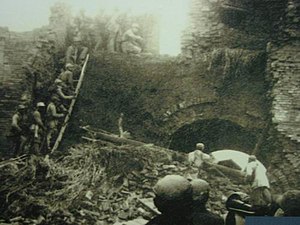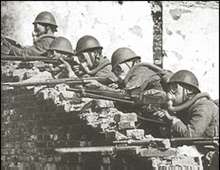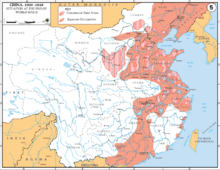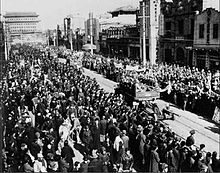Chinese Civil War
Chinese Civil War

People's Liberation Army soldiers attack Nationalist buildings in Shangtang
The Chinese Civil War was a military conflict from 1927 to 1949 over political leadership in the country. It broke out after the brief, worldwide era of bourgeois revolutions of the early 20th century, which was characterized in post-revolutionary China by a frequent succession of Beiyang-era bourgeois governments and shifting alliances of warlords. The civil war, which lasted a total of 22 years, was interrupted by breaks such as the 1937-1946 Standstill Agreement during the Japanese invasion (see Second Japanese-Chinese War) and did not end until the Cold War era.
The protagonists in this conflict were the right wing of the Kuomintang under Chiang Kai-shek, who had led the Republic of China as generalissimo, temporary president and prime minister since 1912, and the opposing Chinese Communist Party under Mao Zedong. These groups had previously cooperated in the so-called First United Front (1923 to 1927) and in the Canton counter-government, but these alliances broke down for several reasons. The left wing of the Kuomintang under Wang Jingwei did not participate on Chiang's side.
While the communists succeeded in establishing the People's Republic of China as a new state system with their victory after more than two decades, the Kuomintang had to retreat with the previous Chinese government to the island of Taiwan, formerly known as Formosa, and established the Republic of China on Taiwan there, which was still considered the legitimate representative of China by most states for several decades until 1971. The civil war had significance not only at the national level. The Comintern and foreign powers (especially the Soviet Union and the USA) supported the warring parties in order to secure their respective influence in China.
Previous story
After the National People's Party of China (Kuomintang) was formed in 1912 and the Communist Party of China in 1921, they first entered into a coalition, the First United Front, in 1924 and led the joint Cantonese counter-government in 1925. The two sides united to launch the Northern Campaign against the warlords of the Beiyang government. The general wars of the so-called Northern Generals; the Zhili(直系)-, Anhui(皖系)-, Fengtian(奉系)-, Ma- (馬家軍) and Guominjun (Kuominchün, 西北軍) factions, for power in Beijing before the Northern Campaign were:
- 1920 Zhili-Anhui War (Zhiwan): Zhili and Fengtian militants defeat the Anhui clique.
- 1922 First Zhili-Fengtian War (Zhifeng I): Zhili clique defeats Anhui and Fengtian militants and Kuomintang.
- 1924 Second Zhili-Fengtian War (Zhifeng II): Zhili clique defeated by Fengtian and Anhui militants and Zhili renegades (Kuominchün).
- 1926 Fengtian-Kuominchün War: Fengtian clique and Zhili remnants defeat Anhui remnants and Kuominchün (Northwest) army, but
- 1926 Northern campaign begins: Kuomintang, Communists and Kuominchün army, defeat Fengtian militants and Zhili remnants.
With the death of the founding father Sun Yat-sen, a power struggle for leadership in the organization flared up within the Kuomintang, which until then had been a national rallying point for opponents of the Manchurian rule of the time. The left wing of the Kuomintang under Wang Jingwei and the Communists formed another counter-government in Wuhan in 1927, where the Communists had a large following.
History
Until the war against Japan
The war began because Chiang was unwilling to continue cooperating with the Communists after their successful joint campaign against the Northern government. He then put down Communist and trade unionist uprisings in Nanchang and Canton beginning in August 1927. The extent to which he was directly involved in the suppression of the next uprising, the Shanghai strike of April 1927, through the Shanghai Massacre, is not documented, since another party to the conflict in this uprising was the underground Triad Society.
At the intervention of the Comintern, the revolutionary idea was to be carried to the peasants in the countryside, and the Communist side attempted to implement this with the Autumn Harvest Uprising in September 1927. This was led for the first time by Mao Zedong, but like the uprisings of the first half of 1927, this enterprise also led to the defeat of the communists or the victory of the right-wing Kuomintang, as a result of which the communists partly retreated into the mountains.
The Communists conquered fifteen territories in South and Central China (Hunan, Fujian) from 1927 and established a Chinese Soviet Republic in Jiangxi (since 1929) (1931). The communists could repel four large-scale attacks of the Kuomintang troops 1930-1934, before the fifth they retreated in the "Long March" 1934/35 to northwest China and could save themselves thus from the crushing, whereupon Mao Zedong became KP chief and in Yan'an (north Shaanxi) a new Soviet republic arose. The Kuomintang had clearly gained the upper hand for the time being and now represented the only relevant political force in the country to the outside world.
During the Second Japanese-Chinese War and World War II.
After the Soviet-Chinese border war, a power vacuum developed in Manchuria. The effect of this conflict led to the Manchurian Crisis in 1931. As a result of the Mukden Incident, Japanese troops occupied Manchuria and established the puppet state of Manchukuo in March 1932. The Japanese parliament viewed the action critically, but since critics were murdered or their voices suppressed, no parliamentary countermeasures were taken. The forces of the Chinese Kuomintang government were insufficient to fight both the Communists and the Japanese. Chiang Kai-shek was forced to recognize the Japanese occupation of Manchuria in 1933 as a condition of an armistice.
At the beginning of the Japanese occupation, the Communists and the Kuomintang were irreconcilably opposed. Chiang Kai-shek continued to proclaim that the fight against the Communists should go forward. After the Xi'an Incident (Chiang's abduction by his own allies to force him into talks with the Communists), he entered into a mutually suspicious coalition between the Kuomintang and Communists in December 1936 that would last until the New Fourth Army Incident in January 1941.
In 1937, the Second Sino-Japanese War broke out after the Marco Polo Bridge Incident. Japanese troops invaded northern China via Manchuria, captured Beijing and advanced towards Shanghai. The Kuomintang initially rejected the armistice offered on November 5, 1937, which included as a condition not only the recognition of Japanese domination of Manchuria and the suppression of anti-Japanese elements but also the joint fight against communism; when the Chinese leadership wanted to accept the offer less than a month later, the military situation for the Japanese had improved so much through the victory in the Second Battle of Shanghai that they no longer wanted to offer an armistice on the conditions mentioned.
After the bloody conquest of Nanjing, then the capital of the Kuomintang government, the Kuomintang's center of power shifted to Chongqing. In Nanjing itself, an anti-communist collaborationist government (the so-called Reorganized Government of the Republic of China) was formed under the leadership of Wang Jingwei and other renegade Kuomintang members. Wang, who belonged to the left wing of the Kuomintang, had already tried to set up a counter-government in Wuhan with the Communists in 1927.
The alliance between the Kuomintang and the Communists continued despite this, with military cooperation between the two sides remaining marked by a lack of communication, open distrust, and regular clashes. Eventually, the alliance broke apart in January 1941 in what became known as the New Fourth Army Incident, after Kuomintang troops attacked the New Fourth Army of the Communist forces as they were clearing Anhui and Jiangsu provinces. In the process, the Communists lost about 7,000 soldiers.
The National Revolutionary Army was increasingly weakened by the open struggle against the Japanese army in the course of the war.
After the end of the Second World War
After Japan's surrender, the USA, faced with the imminent danger of a widening ideologically motivated war in East Asia, was quickly determined to persuade both parties to negotiate a peaceful solution. Thus, until 1947, there were several meetings between the leaders of both sides; among them, on August 28, 1945, two weeks after the Japanese surrender, between Mao Zedong and Chiang Kai-shek in Chongqing. The American general and later Secretary of State George C. Marshall was entrusted with the role of negotiator until 1947.
The main theater of the civil war, which nevertheless soon flared up again, was initially Manchuria, occupied by Soviet troops after the Japanese surrender. The armistice between the USA and Japan contained the condition that the Japanese troops remaining here had to surrender to the Chinese armed forces. A "race" between the Communists and the Kuomintang quickly ensued to see to whom the Japanese troops would surrender. This race intensified the rivalry between the two parties, as the Kuomintang saw itself as the only legitimate government. However, the Soviet occupation forces had purposefully worked to supply the Chinese Communists with Japanese looted weapons, as well as training Communisttroops for what was (both sides assumed) imminent civil war. The Chinese Communists had de facto moved their entire power base to Manchuria and, with Soviet help, began building a civilian administration and a network of party offices. Chiang Kai-shek was concerned about this communist takeover of Manchuria, with its industrial infrastructure created mainly during the Japanese occupation, and therefore requested that the planned withdrawal of Soviet occupation troops from Manchuria be delayed until the Kuomintang had also been given the opportunity to expand their influence in Manchuria. The Soviet government complied with this request and used the time gained to remove the Japanese industrial plants to the USSR.
After World War II, the USSR, at the request of its allies, had to commit itself to recognizing the Kuomintang as the regular Chinese government. Soviet recognition of the national government also meant a commitment to support it alone. In fact, Stalin had already been providing substantial financial assistance to the Chinese Communists again since early 1945. The money and arms deliveries to the CCP were carried out by the Soviet leadership under maximum secrecy, because this was a blatant violation of the treaty that Stalin had concluded with the Allies.
With strong U.S. financial and military support, the Kuomintang finally began to wrest control of Manchuria in the fall of 1945. The Communists, under the command of Lin Biao, engaged in an open field battle near Siping on the railway line to the north, with heavy losses, which lasted for a month. At last Lin Biao sent some 100,000 factory workers from Changchun to fight. However, as American pressure to enter diplomatic talks increased, the Kuomintang agreed to the ceasefire demanded by the Communists, and also undertook the disarmament of some 1.5 million troops.
It was probably this decision to abandon hostilities, as demanded by the Americans, in favor of a peaceful settlement with the Communists that deprived Chiang of victory. The Communists seized the opportunity to further reinforce their forces and surrounded the Kuomintang troops in their garrisons, using their anti-aircraft defenses to cut off supplies to the Nationalist forces. In addition, popular support for the Kuomintang troops and their overall fighting morale remained low, partly due to widening corruption problems and the high rate of inflation as a result of the large debts accumulated by the Kuomintang government during the course of the ongoing armed conflict.
Thus, while the struggle in Manchuria continued, the Communists instigated smaller guerrilla wars in the rest of China to keep more Nationalist troops out of Manchuria. In fact, their plan succeeded: in 1948, the last Kuomintang troops in Manchuria surrendered. At this point, the real decision of the civil war had been made: The Communists, after massively reinforcing their conventional forces, quickly conquered northern China and moved south from there.
The decisive battle of the war took place at Huaihai in central China. Six hundred thousand CCP soldiers fought here against a numerically superior Nationalist army. In this battle, which lasted over two months from November 1948, the Nationalist troops were almost completely annihilated.
In 1949 Chiang Kai-shek finally had to admit defeat. He retreated with his Kuomintang and some 2 million civilians to Taiwan, while Communist leader Mao Zedong proclaimed the People's Republic of China on October 1, 1949. Kuomintang remnants isolated in the southwest retreated to northern Burma and northern Thailand and were partially evacuated to Taiwan. A significant portion of the remaining troops, as well as their civilian supporters, turned to opium cultivation here in the "Golden Triangle." In May 1950 the island of Hainan was conquered by the communists. This was the end of the last major fighting of the Chinese Civil War, not necessarily of this war as such.

House Fight in Shanghai (1937)

Proclamation of the People's Republic of China by Mao Zedong on 1 October 1949

Situation at the end of the Second World War: Communist base areas

Entry of the People's Liberation Army into Beijing 1948
Questions and Answers
Q: What is the Chinese Civil War?
A: The Chinese Civil War was a civil war fought from 1927 to 1949 between the Chinese Communist Party (CCP) and the Kuomintang (KMT, or Chinese Nationalist Party). It was a fight for legitimacy of the government of China.
Q: When did the war begin?
A: The war began in April 1927 because of the Northern Expedition.
Q: How long did it last?
A: The war lasted until 1950, although some people say that it has not officially ended.
Q: What caused the KMT's loss in Mainland China?
A: The KMT's loss in Mainland China was due to several factors, including the Yan'an Rectification Movement which helped Mao have more control of the CCP, a ceasefire made by a United States officer in 1946 which stopped the KMT temporarily, problems between people and KMT in places under its control, Soviet Union giving Japanese guns to CCP, and uncertain help from United States to KMT.
Q: Is there still tension between ROC and PRC today?
A: Yes, relations between Republic of China (ROC) and People's Republic of China (PRC) are still poor because both claim to be legitimate sovereign government of all of China.
Q: Was this part of World War 1 or World War 2?
A: No, this was part of Interwar period after WW1 from 1918-1939 and also part Cold War after WW2 from 1945-1949.
Search within the encyclopedia